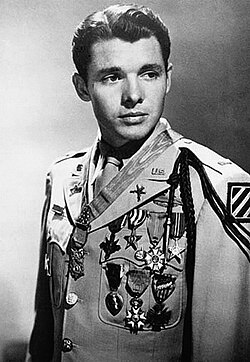

Audie Murphy (20 June 1925 – 28 May 1971) was one of the most decorated United States Army combat soldiers of World War II, serving from 1942 to 1945. He received every American combat award for valor available at the time of his service, [ALM 1] including the Medal of Honor. He also received recognitions from France and Belgium. With his 1945 military discharge at the end of the war, Murphy became an advocate of treatment for post-traumatic stress disorder in veterans. [3] The Audie L. Murphy Memorial VA Hospital in San Antonio and the Sergeant Audie Murphy Clubs (SAMC) on military bases honor his contributions. He joined the Texas National Guard in 1950, transferring to reserve status in 1956 and remaining in the Guard until 1969. He also had a civilian career as a film actor and songwriter. Recognitions he received both during his lifetime and posthumously are listed below.
Contents
- U.S. medals, awards, decorations and badges
- U.S. military personal decorations
- U.S. military unit awards
- U.S. non-military personal decorations
- U.S. military service and campaign medals
- Badges
- Non-U.S. military personal decorations, unit awards and service medals
- U.S. State defense forces
- Service ranks
- Other honors
- Sergeant Audie Murphy Club
- U.S. government, military and veterans organizations
- Texas (non-military)
- Other U.S. states
- Non-United States
- Entertainment industry
- Freemasonry
- Books
- Notes
- Footnotes
- Citations
- References
- External links
Murphy participated in campaigns in North Africa, Sicily, Italy, France and Germany, as denoted by his European-African-Middle Eastern Campaign Medal with one silver battle star (denoting five campaigns), four bronze battle stars, plus a bronze arrowhead representing his two amphibious assault landings at Sicily and southern France. [4] On 25 February 1945 and 3 March 1945, he received two Silver Stars for further heroic actions. [5] The French government awarded Murphy its Chevalier of the Legion of Honor [6] and two Croix de guerre medals. [7] [8] He received the Croix de guerre 1940 Palm from Belgium. [8] The military assisted him with replacement medals after he gave away the originals. [ALM 2] Duplicates of his Medal of Honor and other medals can be viewed at Dallas Scottish Rite Temple museum.



